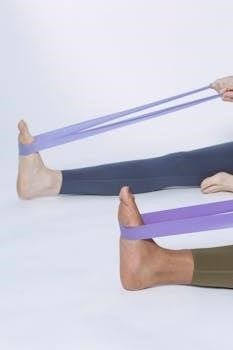
Resistance band workouts are a versatile way to exercise at home. They are a great option for any age and fitness level. These workouts use bands to provide tension, increasing strength effectively. Resistance bands are low impact. They are also cost-effective and space-saving.
What are Resistance Bands?
Resistance bands are elastic strips or tubes used for strength training. They come in various forms, including loop bands, tube bands with handles, and therapy bands. These bands provide resistance when stretched, challenging muscles during exercise. Unlike weights, resistance bands offer variable resistance, increasing as the band stretches further. This makes them suitable for all fitness levels. They are lightweight and portable, making them ideal for home workouts. They are also joint-friendly, providing a low-impact way to build strength. The bands offer a versatile way to perform a wide range of exercises. They can target different muscle groups.

Types of Resistance Bands
Resistance bands come in various types, including loop bands, tube bands with handles, and figure-8 bands. Each type offers unique benefits for different exercises and fitness levels. The bands are an easy way to work out at home.
Loop Bands
Loop resistance bands are a single band formed in a loop, making them ideal for lower body exercises and some upper body movements. They are versatile and can be used for squats, glute bridges, and various leg exercises. These bands provide consistent resistance throughout the exercise, helping to engage muscles effectively. Loop bands are often preferred for their simplicity and ease of use. They come in various resistance levels, allowing users to progressively increase the challenge. Loop bands are a great choice for beginners and experienced fitness enthusiasts alike, making them a valuable addition to any home workout routine. They are also easy to store.
Tube Bands with Handles
Tube bands with handles offer a different approach to resistance training, providing a comfortable grip for various upper body exercises. The handles allow for a secure hold, making exercises like bicep curls, tricep extensions, and rows easier to perform with proper form. These bands are versatile and can be used for a wide range of movements, including chest presses and shoulder exercises. The added handles reduce strain on the hands and wrists, enhancing the overall workout experience. Tube bands are often preferred for exercises that require a strong, stable grip, making them a great option for strength training at home. They are also easy to transport.
Benefits of Using Resistance Bands
Resistance bands are cost-effective, require minimal space, and are low-impact. They improve strength and flexibility, making them suitable for all fitness levels. They also help to improve heart health.
Cost-Effective and Space-Saving
Resistance bands are a remarkably cost-effective workout option, often requiring an investment of under $50 for a diverse set. This makes them an accessible alternative to pricier gym equipment. Their compact nature is ideal for home workouts, requiring minimal space for both use and storage. This makes them perfect for those with limited living areas or for individuals who prefer exercising without the need for a dedicated gym space. The bands can be easily stored away, ensuring they don’t clutter your living area while providing great workout options.
Low-Impact Strength Training
Resistance bands provide a low-impact alternative to traditional weight training and plyometrics. This makes them suitable for individuals of all ages, including beginners and those undergoing rehabilitation. The exercises are gentle on the joints, reducing the risk of injury while still providing effective muscle strengthening. This makes them an excellent choice for progressively building form. The constant tension of resistance bands allows for a full range of motion, engaging muscles throughout each exercise. This ensures a safe and effective workout, emphasizing proper technique with minimal stress on joints, aiding to improve strength.

Resistance Band Exercises by Muscle Group
Resistance bands can be used for a variety of exercises targeting all major muscle groups. These exercises are divided into lower and upper body routines, ensuring a comprehensive full-body workout.
Lower Body Exercises
Resistance bands are excellent for lower body workouts, targeting glutes, hips, calves, and hamstrings. Exercises like glute bridges and hip thrusts can effectively engage the gluteal muscles. Banded squats and lateral walks work the thighs and hips. You can also use bands for hamstring curls and donkey kickbacks. These exercises can be a great leg day option. These can be mixed with core and arm exercises for a full-body routine. Using resistance bands for lower body exercises is a great way to build strength and improve muscle tone. Remember to always use proper form.
Upper Body Exercises
Resistance bands are a great tool for upper body exercises, targeting the shoulders, back, and arms. Exercises like resistance band shrugs and pull-aparts can strengthen the shoulder muscles. Banded reverse flies help to improve shoulder mobility and definition. Chest flys and bicep curls are effective for the chest and arms. Tricep extensions and shoulder presses are also good options. This comprehensive approach can help you build upper body strength. These exercises target anterior, lateral, and medial deltoids. They can increase strength, definition, and mobility. Using a variety of these exercises helps to build a well-rounded upper body.

Creating a Resistance Band Workout Routine
To create a resistance band routine, select exercises for each muscle group. You can perform them as a circuit or in sets. Rest between circuits. Aim for 8-12 repetitions for each exercise. Consistency is key for best results.
Structuring Your Workout
When structuring your resistance band workout, begin with a warm-up to prepare your muscles. Next, choose exercises that target different muscle groups. You can arrange these exercises into a circuit, performing each one after the other. Alternatively, focus on one muscle group at a time. Include exercises for both upper and lower body, and core engagement. Aim for 8-12 repetitions per exercise, completing 2-3 sets. Allow for short rest periods between exercises, and longer rests between sets. Cool down and stretch after your workout. Remember to adjust the intensity as needed, and progressively increase resistance to challenge yourself.
Free Printable Resistance Band Exercise Chart PDF
A free printable resistance band exercise chart PDF is a valuable tool. It offers structured plans with visuals, aiding proper form. This chart is a great reference for beginners and experienced users.
Using the Chart for Beginners
For beginners, the resistance band exercise chart PDF is a user-friendly guide. Start by familiarizing yourself with the visual aids demonstrating proper form. Select a few exercises from each muscle group. Begin with lower repetitions, focusing on technique. Gradually increase reps or sets as strength improves. The chart is broken down into muscle groups for easy use. This allows for a balanced workout. The chart also helps you tailor routines to your fitness level. It is designed to help you see results, fast. Remember to consult your physician before beginning any new workout program. This chart provides a structured plan to follow.
Tips for Proper Form and Technique
Proper form is crucial for effective and safe resistance band workouts. Focus on controlled movements, avoiding jerky motions. Maintain a stable core and correct posture throughout each exercise. Always use the right band tension.
Ensuring Effective and Safe Workouts
To maximize the benefits and minimize the risk of injury during resistance band workouts, it’s essential to prioritize proper form and technique. Before starting any exercise, ensure the band is secure and not damaged. Begin with a lighter resistance to master the movement pattern. Maintain a controlled pace, avoiding jerky or rushed actions. Focus on engaging the targeted muscles throughout the exercise. If you feel any pain, stop immediately and adjust your form or band tension. Consistent, controlled movements will lead to better results and prevent strains or other injuries. Proper form ensures the targeted muscle groups are activated, enhancing strength gains and overall workout effectiveness. Remember to listen to your body and adjust as needed.

Sample Resistance Band Workout Plan
A full-body resistance band routine can include exercises like squats, chest flys, bicep curls and rows. Add tricep extensions, shoulder presses, hamstring curls, and donkey kickbacks. This creates a balanced and effective workout.
Example Routine for Full-Body Workout
Begin with a set of 12 repetitions of chest flys, followed by 15 reps of bicep curls. Next, do 12 reps of squats and then 15 reps of tricep extensions. Continue with 10 repetitions of shoulder presses, 10 reps of bent over rows and 12 reps each of hamstring curls and donkey kickbacks. Complete 2-3 sets of each exercise for a balanced approach to full body strength training. Rest between sets for 30-60 seconds. Aim for three sessions per week lasting approximately 20 minutes each to see results.